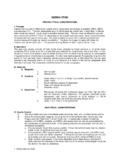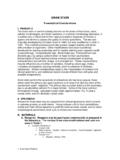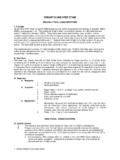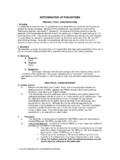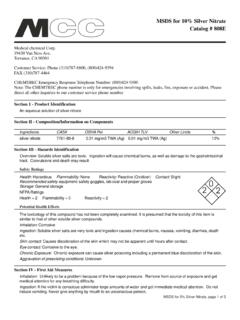Transcription of Wheatley's TRICHROME STAIN - Med-Chem
1 1 wheatley s TRICHROME (Modification of Gomori TRICHROME ) Protocol wheatley S MODIFICATION OF THE GOMORI TRICHROME STAIN Preanalytical Considerations I. PRINCIPLE It is generally recognized that stained fecal films are the single most productive means of stool examination for intestinal protozoa. The permanent stained smear facilitates detection and identification of cysts and trophozoites and provides a permanent record of the protozoa found. The TRICHROME technique of wheatley for fecal specimens is a modification of Gomori s original staining procedure for tissue. It is a rapid, simple procedure that produces uniformly well-stained smears of intestinal protozoa, human cells, yeast cells, and artifact material. II. SPECIMENS The specimen usually consists of unconcentrated fresh stool smeared on a microscope slide and immediately fixed in Schaudinn s fixative or of polyvinyl alcohol (PVA)-preserved stool smeared on a slide and allowed to air dry.
2 Stool preserved in sodium acetate-acetic acid-formalin (SAF) or any of the single-vial fixatives for parasitology are also acceptable. III. MATERIALS A. Reagents: Reagents may be purchased commercially or prepared in the laboratory. a. TRICHROME ( wheatley s formulation) i. Chromotrope g ii. Light green g iii. Phosphotungstic g iv. Acetic acid (glacial).. ml v. Distilled ml Prepare the STAIN by adding ml of acetic acid to the dry ingredients. Allow the mixture to stand (ripen) for 30 min at room temperature. Add 100 ml of distilled water. Properly prepared STAIN will be purple in color. The staining solution should be protected from light. Store in a glass or plastic bottle at room temperature. The shelf life is at least 24 months. b. 70% ethanol c. 70% ethanol plus iodine Prepare a stock solution by adding iodine crystals to 70% ethanol until you have a dark solution (1-2 g/100 ml). To use, dilute the stock solution with 70% alcohol until a dark reddish brown (strong tea color) is obtained.
3 As long as the color is acceptable, new working solution does not have to be replaced. Replacement time will depend on the number of smears stained and the size of the container (1 to several weeks). d. 90% ethanol, acidified 2 wheatley s TRICHROME (Modification of Gomori TRICHROME ) Protocol 90% ethanol ml acetic acid (glacial) ml Prepare by combining. e. 100% ethanol f. Xylene (or xylene substitute) B. Supplies a. Glass slides (25 by 75 mm), frosted ends desirable b. Coverslips (22 by 22 mm; no. 1) c. Glass or plastic pipettes d. Coplin jars or other suitable staining containers e. Immersion oil C. Equipment: Optional materials, depending on specimen source of laboratory protocol a. Binocular microscope with 10X, 40X, and 100X objectives (or the approximate magnifications for low power, high dry power, and oil immersion examination). A 50X or 60X oil immersion objective is also very helpful in screening stained smears.
4 B. Oculars should be 10X. Some workers prefer 5X; however, overall smaller magnification may make final organism identifications more difficult. c. Fume hood to contain staining setup (optional) Analytical Considerations IV. QUALITY CONTROL A. Stool samples used for QC can be either fixed stool specimens known to contain protozoa or PVA-preserved negative stools to which buffy coat cells have been added. Use a QC smear prepared from a positive PVA specimen or PVA containing buffy coat cells when new STAIN is prepared or at least once each week. Cultured protozoa can also be used; however, very few laboratories provide intestinal protozoan culture methods. B. Include a QC slide when you use a new lot number of reagents, when you add new reagents after cleaning the dishes, and at least weekly. C. If the xylene becomes cloudy or has an accumulation of water in the bottom of the staining dish, use fresh 100% ethanol and xylene. D.
5 Cover all staining dishes to prevent evaporation of reagents E. Depending on the volume of slides stained, change staining solutions on an as-needed basis. F. When the smear is thoroughly fixed and the STAIN is performed correctly, the cytoplasm of protozoan trophozoites will be blue-green, with sometimes a tinge of purple. Cysts tend to be slightly more purple. Nuclei and inclusions (chromatoid bodies, RBCs, bacteria, and Charcot-Leyden crystals) are red, sometimes tinged with purple. The 3 wheatley s TRICHROME (Modification of Gomori TRICHROME ) Protocol background material usually stains green, providing a nice color contrast with the protozoa. This contrast is more distinct than that obtained with the hematoxylin STAIN . G. The specimen is also checked for adherence to the slide (macroscopically). H. The microscope should be calibrated, and the objectives and oculars used for the calibration procedure should be used for all measurements on the microscope.
6 The calibration factors for all objectives should be posted on the microscope for easy access (multiplication factors can be pasted on the body of the microscope). Although recalibration every 12 months may not be necessary, this will vary from laboratory to laboratory, depending on equipment care and use. Although there is not universal agreement, the microscope should probably be recalibrated once each year. This recommendation should be considered with heavy use or if the microscope has been bumped or moved multiple times. If the microscope does not receive heavy use, then recalibration is not recommended on a yearly basis. I. Known positive microscope slides, Kodachrome 2 x 2 projection slides, and photographs (reference books) should be available at the work station. J. Record all QC results, including a description of QC specimens tested; the laboratory should also have an action plan for ``out of control'' results. V.
7 PROCEDURE A. Wear gloves when performing this procedure B. Slide preparation 1. Fresh Fecal specimens a. When the specimen arrives, prepare two slides with applicator sticks and immediately (without drying) place them in Schaudinn s fixative. Allow the specimen to fix for a minimum of 30 min; overnight fixation is also acceptable. The stool smeared on the slide should be thin enough that newsprint can be read through the smear. Proceed with the TRICHROME staining smear. b. If the fresh specimen is liquid, place 3 or 4 drops of PVA on the slide, mix several drops of fecal material with the PVA, spread the mixture, and allow it to dry for several hours (1 hour minimum) in a 35 - 37 C incubator or overnight at room Proceed with the TRICHROME staining procedure by placing the slides in iodine-alcohol. 2. PVA-preserved fecal specimen (mercuric chloride base) 1 Remember that this approach is reserved for liquid stools only; do not use this approach with semi-formed or formed stool.
8 There will not be enough contact between the fixative and stool to preserve any organisms that might be present. 4 wheatley s TRICHROME (Modification of Gomori TRICHROME ) Protocol a. Allow the stool specimens that are preserved in PVA to fix for at least 30 min. Thoroughly mix the contents of the PVA bottle with two applicator sticks. b. Pour some of the PVA-stool mixture onto a paper towel, and allow it to stand for 3 min to absorb the PVA. Do not eliminate this c. With an applicator stick, apply some of the stool material from the paper towel to two slides, and allow them to dry for several hours (minimum 1 hour) in a 35 - 37 C incubator or overnight at room temperature. d. Place the dry slides into iodine-alcohol e. If the stool was not thoroughly mixed with PVA by the patient, apply some stool material to two slides and immediately immerse in Schaudinn s fixative for a minimum of 30 min; then proceed with the TRICHROME 3.
9 Modified PVA-preserved fecal specimens (copper or zinc base, single-vial systems) a. Allow the stool specimens that are preserved in PVA or other fixative to fix for at least 30 min. Thoroughly mix the contents of the fixative vial with two applicator sticks. b. Pour some of the fixative-stool mixture onto a paper towel, and allow it to stand for 3 min to absorb the PVA. Do not eliminate this step if the fixative contains PVA. c. With an applicator stick, apply some of the stool material from the paper towel to two slides, and allow them to dry for several hours (minimum of 1 hour) in a 35 - 37 C incubator or overnight at room temperature. d. Begin the TRICHROME staining process by placing the slides into a dish of 70% alcohol then TRICHROME STAIN , or the slides can be placed directly into the TRICHROME STAIN step (iodine-alcohol step can be eliminated). 4. SAF-preserved fecal specimens a. Thoroughly mix the SAF-stool mixture, and strain through gauze into a 15-ml centrifuge tube.
10 B. After centrifugation (10 min at 500 Xg), decant the supernatant fluid. The final sediment should be about to ml. If necessary, adjust by repeating step a (if too little sediment is present) or by suspending the sediment in saline ( NaCl) and removing part of the suspension (if too much sediment is present). 2 If you take the specimen directly from the specimen, you may get too much PVA and not enough stool; the amount of PVA required to glue the specimen onto the slide is very minimal. Too much PVA on the slide may cause the material to fall off during processing. 3 If the lag time between specimen passage and fixation is too long, regardless of the extra fixation step in Schaudinn s fixative, the overall organism morphology may be marginal. You can also scrape some stool from that portion that has been in contact with the fixative and use that for smear preparation. 5 wheatley s TRICHROME (Modification of Gomori TRICHROME ) Protocol c.
